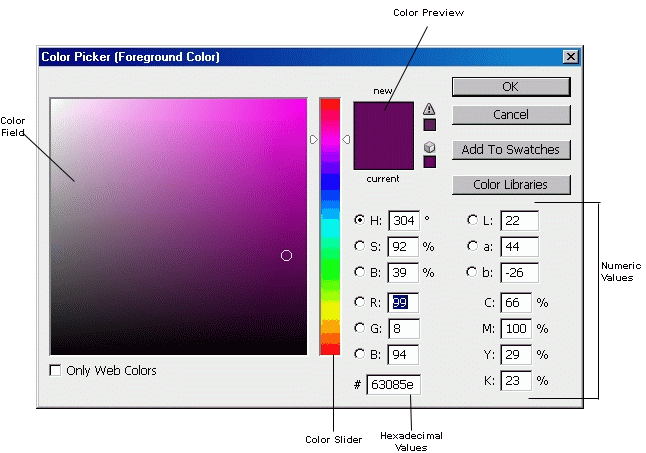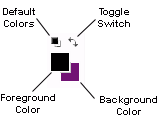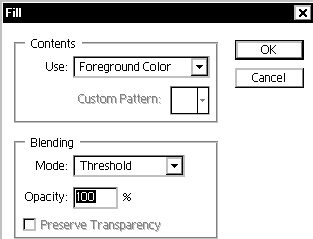How To Change Colors In Adobe Sketch
-
COVID-xix Notice
Acquire more than about UWEC'due south COVID-19 response.
(Athenaeum) Adobe Photoshop CS3: Working with Colors
Last updated
This article is based on legacy software.
With Photoshop, you can alter the appearance of an image by changing the colors that make up the image. Photoshop allows yous to work with the Foreground colour and the Background color. These color choices also correspond to the various drawing tools included with Photoshop (eastward.one thousand., the Paint Bucket tool and Brush tool).
Selecting Colors
You tin can move between 2 color options at a time, the Foreground and Background colors. The Background and Foreground colors are used differently by each tool. For case, the Brush tool uses whatever color is in the Foreground box. The Background and Foreground colors can be switched at any time.
The Color Picker Dialog Box
The Color Picker dialog box allows you 4 options to set the color: the color field, the color slider, numeric values, and hexadecimal values. The Color Picker opens when you go to select a color using the Toolbox 
| Option | Definition |
|---|---|
| Color Field | Identify which color will be added past moving a small circumvolve which appears in the Color Field. |
| Color Slider | Change the colour tone by moving the arrows along the bar or by clicking within the Color Slider. |
| Numeric Values | Select a color past typing the numeric value in the group of text boxes. Four groups of text boxes appear:
|
| Hexadecimal Values | Enter a half-dozen digit hexadecimal value representing the color you want. |
Using the Color Picker Dialog Box
HINT: The Toolbox is located at the left hand side of the work area by default. If the Toolbox is non visible, re-select it in the View menu.
-
From the Toolbox, click the Foreground or Groundwork colour square.
The Colour Picker dialog box appears.

-
Using the Color Picker dialog box, select the desired colour.
Your option appears in the Color Preview box. -
When you have decided on a color, click OK.
Your new color now appears on the Toolbox in the color square that you clicked in step one.
Moving Between Foreground and Background Colors
The Color Pick box on the Toolbox contains a toggle switch to alternate betwixt the Foreground and Background colors.
-
In the Colour Selection box, click the Toggle Switch.
The background colour has now moved to the foreground colour.

Using the Foreground and Groundwork Default Colors
In addition to your Foreground and Groundwork colors, the Color Selection box on the Toolbox also contains default blackness and white colors.
-
In the Color Selection box, click Default Colors.

The default black and white colors have now become your foreground and background colors, respectively.
Notation: Any custom colors yous previously selected volition disappear.
Recoloring Graphics
Photoshop allows you to recolor images. For example, if you wish to modify the colour scheme of a certificate, you tin can recolor related images in Photoshop. The active Foreground or Background colour can be applied to any selected area of the image. For information on how to select an area, refer to Selecting an Area.
Recoloring Graphics: Using the Fill Command
One fashion to change the color of an paradigm is by using the Fill command. The Fill dialog box allows yous to fill with either the Foreground or Background color, or with black, white, or grayness.
-
If y'all will be using the Foreground or Background color, verify that the color is correct.
-
Select the area you lot wish to employ color to.
For information on how to select an expanse, refer to Selecting an Area. -
From the Edit menu, select Make full...
The Fill dialog box appears.

-
From the Utilize pull-down listing, select the desired pick.
-
(Optional) In the Blending section, make whatever necessary changes to the Opacity and/or Mode setting.
-
Click OK.
Your selected area is filled with the color y'all chose.
Recoloring Graphics: Using the Paint Bucket
You can utilise the Paint Bucket tool to alter the color of an image. The Paint Bucket tool does non require you to select the surface area to be filled. The Paint Saucepan tool, similar the Magic Wand, selects like-colored pixels to fill up. Yous can affect which pixels are filled by adjusting the tolerance.
NOTE: The Pigment Bucket command volition not work on a bitmap image. If this tool is not available, check your paradigm way. For additional data on image modes, refer to Special Terms: Image Modes.
-
From the Prototype menu, select Style.
-
Select RGB Colour.
Annotation: The selection is selected if a checkmark appears before it. -
Select your desired Foreground color.
- From the Toolbox, select the Paint Saucepan Tool .

NOTE: If it is non visible, it is hidden behind the Slope Tool.
- To display the Pigment Bucket Tool, click and agree the mouse over the Gradient Tool.
OR
Correct click the Gradient Tool and select Paint Bucket Tool.

-
Position the Paint Bucket Tool over the area you would similar to color.
-
Click the mouse.
The surface area you pointed to is at present filled with the Foreground color.
Source: https://www.uwec.edu/kb/article/adobe-photoshop-cs3-working-with-colors/
Posted by: robinsonboweache.blogspot.com


0 Response to "How To Change Colors In Adobe Sketch"
Post a Comment